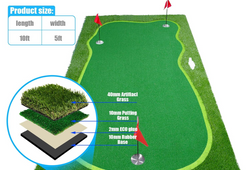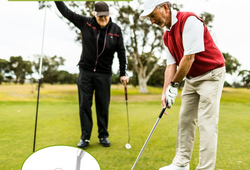

The maintenance of golf clubs directly affects the feel of the shot, accuracy and lifespan. Different components (the head, the shaft, and the grip) have different materials and functions, and the maintenance methods need to be targeted. Here is a systematic and practical guide for maintaining golf clubs, covering daily maintenance, deep cleaning, long-term storage, and special precautions.
1. Core component maintenance: Follow the steps of "head - shaft - grip" for operation.
1. Head maintenance: Avoid wear, rust and performance decline.
The head is the core of the shot, and the materials are mostly stainless steel, titanium alloy (for woods / hybrid clubs), soft iron (for pitching clubs / putting clubs) or carbon fiber (for some lightweight heads). Key points are to prevent scratches, dents and rust.
Daily cleaning (must be done after each round):
Use a soft-bristled brush (made of nylon, avoiding metal brushes) dipped in a small amount of water (or neutral soap water, only for stubborn stains) to gently scrub the bottom and grooves of the head of dirt and grass debris. The debris in the grooves will seriously affect spin, and must be cleaned thoroughly.
Dry with a clean microfiber cloth, avoiding water residue (especially for stainless steel / soft iron heads, dampness is prone to rust).
Deep maintenance (every 1-2 months or after 10 rounds):
Check if the head has dents, scratches or edge curling (common in iron clubs / pitching clubs when hitting poorly), minor scratches can be ignored, deeper damage requires sending to a professional workshop for repair (avoid self-grinding, which may change the weight and hitting surface angle of the head).
For soft iron heads (such as forged irons), you can apply a small amount of head protection oil (special metal maintenance oil, not ordinary engine oil) regularly (every 3 months) to form a protective film, preventing oxidation and rust.
Prohibition of use:
Avoid hitting hard surfaces with the head (such as concrete, rocks), to prevent the head from deforming or the hitting surface from becoming concave.
The head of a wood / hybrid club is large in volume and has a brittle material, do not "stick" the club to the ground (especially in strong winds or uneven ground), as this may cause the connection between the head and the shaft to break.
2. Shaft maintenance: Prevent bending, cracking and coating detachment.
The main material of the shaft is carbon fiber (over 90% of the total, lightweight and high elasticity) or steel (traditional material, heavy and stable). The core is to protect the coating and structural integrity.
Daily cleaning:
After each round, use a microfiber cloth dipped in water to wipe the surface of the shaft, removing sweat, dirt and dust from the course (sweat contains salt, long-term residue will corrode the coating of the shaft).
If the shaft has stubborn stains (such as grass juice, oil stains), use a small amount of neutral soap water to wipe, avoid using strong solvents (such as alcohol, gasoline, etc.) (which will dissolve the carbon fiber coating, causing fading or cracking).
Deep inspection (every 1-2 months):
Focus on checking the connection between the shaft and the head (sleeve) and the connection between the shaft and the grip: check for cracks, detaching glue (common in carbon fiber shafts), or rust on the steel shaft (mostly due to moisture seeping into the connection).
Hold the head and gently rotate the shaft to feel if it is loose (if loose, send to the workshop for re-gluing to avoid shaking during the shot).
Prohibition of use:
Do not place the club in a high-temperature environment (such as a car trunk exposed to the sun, carbon fiber shafts have poor heat resistance and are prone to deformation; steel shafts have coating that will flake off due to moisture seepage).
Avoid colliding the clubs with each other (especially carbon fiber shafts, the surface coating is thin, collision is likely to cause scratches, affecting appearance and durability).
3. Grip maintenance: Maintain stickiness and prevent slipping (affecting shot stability)
The grip is mostly made of rubber (ordinary model), polyurethane (sticky model) or cotton thread (sweat-absorbing model), the core is to keep the surface clean and elastic, avoiding slipping due to aging or dirt.
Daily cleaning (after each round):
Wet the handle surface with warm water using a microfiber cloth to remove sweat, dust, and oil stains (sweat residue can harden the rubber handle and cause the polyurethane handle to lose its adhesion). For cotton-handled grips, gently press and wipe to avoid pulling them off; after cleaning, let them air dry naturally and avoid direct sunlight exposure (it will accelerate aging).
Deep maintenance (every 3-6 months, or adjusted according to usage frequency):
Check if the handle is hardened, cracked, or has lost surface adhesion (common for rubber handles), or if the cotton thread is damp and moldy (often due to not drying in time).
If the handle slips severely (even after cleaning there is no adhesion), or if there are obvious cracks, it is recommended to replace the handle (the handle is a consumable item, usually amateur players replace it once a year, and frequent users replace it every six months).
Regularly (every 2 months) use handle-specific cleaning solution (to enhance adhesion and extend service life), but avoid using solvents such as alcohol (it will corrode the handle material).
Precautions:
Do not wear dirty gloves when holding the club (the dirt on the gloves will accelerate the wear of the handle); remove the handle cover promptly after playing (especially when it is damp, a sealed environment is prone to bacterial growth and mold).
Avoid soaking the handle in water for a long time (it will cause the rubber handle to expand and fall off).
II. Daily Storage: Avoid Environmental Damage
The storage environment of the club is the key factor affecting its lifespan, and it needs to be away from the "high temperature, high humidity, and compression" three killers.
Short-term storage (for daily use at home):
Store in a dedicated ball bag, and the compartments inside the ball bag need to fix each club independently to avoid collision between the club heads; the bottom of the ball bag should be placed stably, not tilted (to prevent the club body from bending).
The storage location should be dry and ventilated (such as next to an indoor wardrobe), avoid placing it in bathrooms, balconies, etc. (to prevent the club head from rusting and the handle from molding).
Long-term storage (such as when changing seasons or not playing for a long time):
Thoroughly clean all clubs (club heads, club bodies, handles) before storage, and completely dry them.
Apply a small amount of anti-rust oil to the connection between the steel club head and the club body (using a cotton swab to dip, to avoid excessive contamination of the handle); carbon fiber club heads do not need to be oiled, just dry the moisture thoroughly.
Place the ball bag upright, do not stack heavy objects (to avoid the club body being compressed and deformed); if the ball bag has side pockets, do not put damp items (such as wet towels, umbrellas) in them.
When carrying out (such as traveling, playing on the course):
Use a hard-shell protected ball bag (especially for air transportation), add club head covers (wooden / mixed clubs must be worn to prevent the club head from colliding and denting) and club body protection covers (to avoid deformation during transportation).
During car transportation, do not expose the club to the sun in the trunk (high temperature environment is harmful to the club body), it is recommended to place it in the rear seat of the car (the temperature is relatively stable).
III. Special Scene Maintenance: Handling Extreme Situations
After playing in rainy weather:
After the game, immediately dry all clubs with a dry cloth (especially the bottom of the club head, the connection between the club body and the handle, and the handle), to avoid rust or mold caused by residual water.
If the handle is soaked by water, you can first press it with a dry cloth to absorb the sweat, then let it air dry naturally (do not use a hair dryer to dry, high temperature will accelerate aging).
After a sand bunker shot:
Clean the sand in the club head groove (use a soft-bristled brush or groove cleaner), the sand particles are hard, long-term residue will wear down the edge of the groove, affecting the spin of the shot (the groove is the key to controlling the ball path, after wear, it needs to be re-milled by a workshop).
After a missed shot (such as hitting the ground, hitting a tree):
Immediately check if the club head is dented, if the club body is bent (you can place the club on a flat surface and roll the club body to observe if it deviates from a straight line), if there is any abnormality, stop using it and send it to a professional workshop for inspection (a bent club body is prone to breakage when hitting, there is a safety hazard).
Summary: Core Principles of Maintenance
"Timely Cleaning" is Prioritized: Spend 5-10 minutes cleaning the club after each round of play. This is more important than regular deep maintenance (to prevent long-term residue of dirt from causing irreversible damage).
"Targeted" Maintenance: Treat differently based on the material (carbon fiber shafts should avoid high temperatures and strong solvents, metal head should avoid dampness and rust, and the grip should avoid corrosion from sweat).
"Regular Inspection" to Prevent Hazards: Focus on the connection points (head - shaft, shaft - grip). Loose or cracked parts need to be addressed promptly to avoid small issues turning into major failures.
Through scientific maintenance, the lifespan of a high-quality golf club (especially high-end carbon fiber clubs) can be extended by 3-5 years, while maintaining optimal playing performance and avoiding equipment issues that affect the playing experience.









